Natural Building around the World: |
 |
 |
|
|
|
|
 |
|
|
|
|
| |
|
Naturally built homes use local, minimally processed, abundant
and/or renewable natural materials. They are designed to suit
their climate and geography, providing a modest shelter that can
lasts for many centuries. Ideally they, and the way they are
lived in, are in balance and harmony with the environment. The resources used to build them
are either so abundant that the impact of their use is not
significant or they are easily replenished within the lifetime of
the building.
This collection shows naturally built homes from different climates using a selection of natural
and recycled
materials and building techniques. |
|
|
|
|
| |
|
|
|
|
|
|
In many parts of the world the traditional
knowledge and skills used to build natural homes has been, or is
being, lost as people become more dependent on a building industry
that generally uses processed non-local materials. Natural homes
are often built with the knowledge and experience of a supportive
community. Here are nine such examples from around the world. |
|
|
|
|
|
|
|
| |
|
|
|
|
|
HempcreteHempcrete is a
mixture of hemp and lime, a lightweight construction material that
can be used for walls, insulation of roofs and floors and as part
of timber-framed buildings. It provides good thermal and sound
insulation. Hemp-based solid wall construction is breathable and
is able to absorb and emit moisture, leading to much healthier
buildings. This small house uses cast hempcrete around a timber
stud frame. The hemp & lime casting-work was filmed during its
construction. See the videos right...
|
|
|
|
|
|
|
|
|
|
|
| |
|
|
|
Canada |
|
Ice
This igloo is in Canada, built in the traditional Inuit way by
cutting blocks from a wind packed snow drift with a saw. This
arctic environment can kill a person quickly, which is why two
experienced
Inuit can build an igloo in about 30 minutes. In a storm this skill can
mean the difference between life and death.
| |
 |
|
| |
Setting the last
ice block in the roof |
|
|
|
|
|
|
|
|
|
|
|
|
| |
|
|
|
England |
|
Mud and Stud
This is a late 17th century
Mud and Stud
cottage in the beautiful Lincolnshire Wolds of England. You can
find Mud and Stud homes in Jamestown, Virginia, USA built there by
British colonists. Mud and stud is similar to 'wattle and daub'
but the mud (clay, sand and straw) is supported by vertical riven
[riven: split with the grain] lathes nailed to horizontal rails
between the posts of an elm frame.
| |
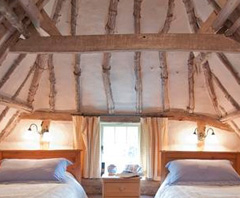 |
|
| |
Lime plastered
attic bedroom |
|
|
|
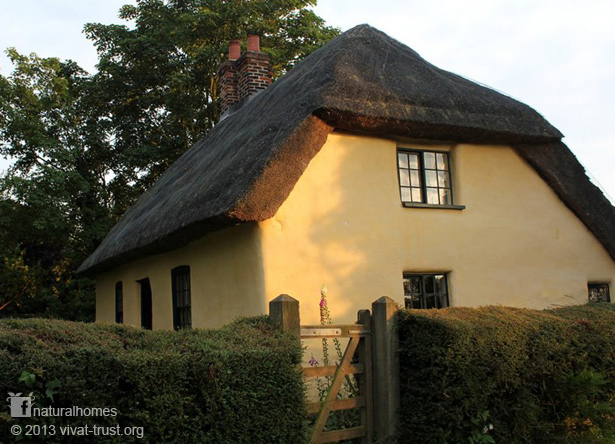 |
|
|
|
|
|
|
|
|
| |
|
|
|
Tunisia |
|
Cave
Matmâta and other desert settlements in Tunisia have wonderful
underground homes built to avoid the intense heat and strong
desert winds. The homes are made by digging a large pit some 7m
(23ft) deep and 10m (33ft) wide and then, around the sides of the
pit, tunnelling in a few meters before cutting artificial caves. Matmâta, like only a handful of similar towns across
Tunisia, is situated on a shelf of sandstone that is soft enough
to excavate with hand tools, but sturdy enough to provide homes
for centuries.
|
|
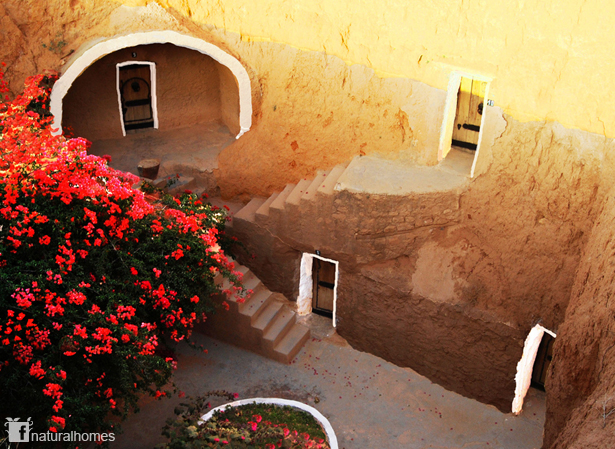 |
|
|
|
|
|
|
|
|
| |
|
|
|
Russia |
|
Hide
This is a
choom in the frozen marshlands of the Yamal Peninsula in
northwest Siberia, Russia. The choom, home to the nomadic Nenet,
uses reindeer hides wrapped around wooden poles. During periods of
migration chooms are moved every other day. Choom sites are chosen
based on pasture and ground quality with a water source nearby. After checking the vegetation on a choom site
the Brigadier pushes his reindeer driving stick, called a khorei,
into the ground where he wants the centre of the choom to be.
|
|
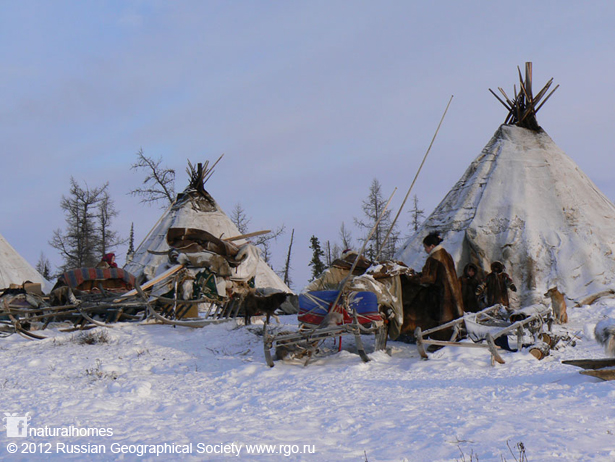 |
|
|
|
|
|
|
|
|
| |
|
|
|
Indonesia |
|
Rattan
These rattan thatched homes are the vernacular
architecture of Wae Rebo Village on Flores island in Indonesia. Rattan is a climbing palm that grows in the tropical and
subtropical regions of Asia and Africa, extending as far north as
Nepal and Bhutan, and as far south as Papua New Guinea. They only
grow in tropical forests. There are approximately 650 species of
rattans.
|
|
|
|
|
|
|
|
|
| |
|
|
|
England |
|
Oak FrameThis beautiful home in Devon, England called Seagull House, was traditionally framed
in oak. It was
converted from a barn in 1987 and designed by architect
Roderick James who founded
Carpenter
Oak where you can see more pictures of the
oak framed house.
The traditionally framed building like this
can last for 500+ years or more.
Peak acorn production for an oak tree is around 80 to 120
years. It takes about 150 years before an oak tree is ready to use
in construction.
|
|
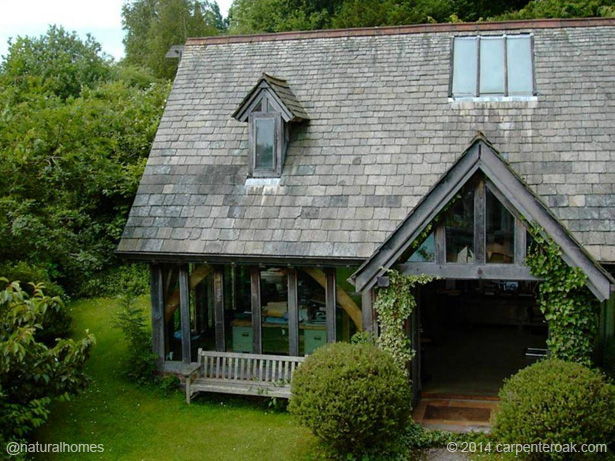 |
|
|
|
|
|
|
|
|
| |
|
|
|
Iran |
|
Rice and Bamboo
This 40m2 bamboo and rice straw shelter is in Ramsar, Iran. It
is made from 70 young and still flexible bamboo poles, arranged
along two semicircular segments at the base. Bundles of rice straw were used to thatch the roof. Rice straw swells in wet
weather keeping the rain out and the inside dry. Conversely when
itís sunny and hot, the dry straw lets air flow in and out keeping
inside comfortably cool. You can find out more about the
structural design at
Architecture in Development (AID).
|
|
 |
|
|
|
|
|
|
|
|
| |
|
|
|
Zambia |
|
Earthbag
This is a 3m diameter earthbag dome in Limulunga, Zambia on the
shore of a lake near Mongu. It was built with a team of 25 people
led by Paluina of
Earth
Hands and Houses. The house, which took two weeks to build, is
made from earthbags, roundwood and grass thatch. Building this way the team
built a home at about a 1/4 of the price of a conventional
concrete block structure. The eco-lodge is in one of 23 villages
around the lake where the community is trying to halt the progress
of cement structures.
|
|
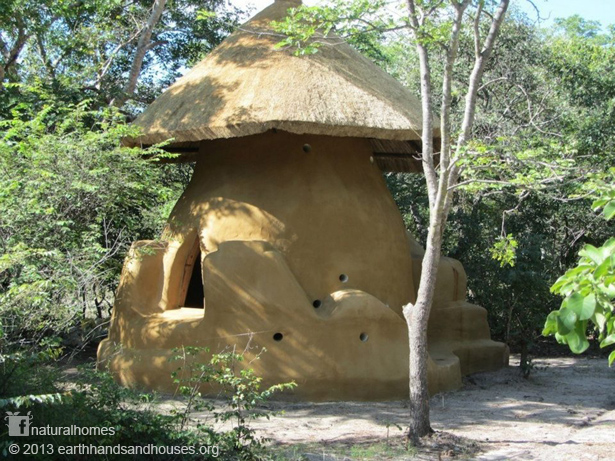 |
|